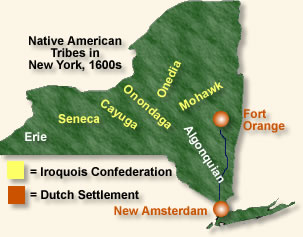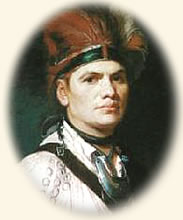|
Living Among the Mohawks, 1644
In 1609 Henry Hudson, an English sea captain under
contract to the Dutch, sailed his ship the Half Moon up what would become
the Hudson River to a point near present-day Albany, NY. Hudson searched for
the elusive Northwest Passage that his Dutch masters hoped would provide them
a short, northern sea route to the lucrative spice islands of the Pacific. His
quest was unsuccessful; but Hudson’s voyage was not a failure. The expedition
did not lead to spices, but it did find another profitable commodity – furs.
 |
|
Distracted by the search for riches in the South Pacific, the West Indies
and South America, the Dutch did not exploit their discovery in North America
until 1621. That year witnessed the formation of the Dutch West India Company
with a monopoly for trade along the shores of the Americas. The colony of New
Netherland was established and its first settlement - Fort Orange - constructed
at the head of the navigable waters of the Hudson River in 1624. Down stream,
the Dutch established New Amsterdam on Manhattan Island where the Hudson meets
the Atlantic Ocean
The Dutch traders were primarily interested in furs – beaver furs for
fashionable hats. Their principal trading partner was the Mohawks who lived
in the area surrounding Fort Orange. The Mohawks were a part of the Iroquois
family of Native Americans that also included the Oneida, Onondaga, Cayuga
and Seneca tribes. Three centuries earlier, hardships, that included famine
and warfare, forced these groups to abandon their homeland in the Mississippi
Valley and make an exodus to the New York area. The Iroquois invasion was a
gradual process in which the tribes carved out separate homelands by ousting
the resident Algonquians. The Mohawks had established themselves in the area
of the headwaters of the Hudson River approximately one hundred years before
the arrival of the Dutch.
The fur trade was beneficial for both the Dutch and the Mohawks. Fort Orange
and New Amsterdam thrived. Soon the Dutch West India Company was enticing
settlers who would convert the forests to farmland to make the voyage across
the Atlantic.
Johannes Megapolensis was a thirty-nine-year-old Dutch minister who made his way to Fort Orange with his wife and four children in 1642. He had a six-year contract with Kilaen van Rensselaer, a director of the West India Company, to fill the spiritual needs of the inhabitants of the area. Megapolensis described his experience in a series of letters that were later published as a book. In the following excerpt, he provides a portrait of the Mohawks:
"The principal nation of all the savages and Indians,
hereabouts with which we have the most intercourse, is the Mohawks who have laid
all the other Indians near us under contribution.
The people and Indians here in this country are like us Dutchmen in body and stature; some of them have well formed features, bodies and limbs; they all have black hair and eyes, but their skin is yellow. In summer they go naked, having only their private parts covered with a patch. The children and young folks to ten, twelve and fourteen years of age go stark naked.
In winter, they hang about them simply an undressed deer or bear or panther skin; or they take some beaver and otter skins, wild cat, raccoon, martin, otter, mink, squirrel or such like skins, which are plenty in this country, and sew some of them to others, until it is a square piece, and that is then a garment for them. . . They make themselves stockings and also shoes of deer skin, or they take leaves of their corn, and plait [braid] them together and use them for shoes.
They generally live without marriage; and if any of them have wives, the marriage continues no longer than seems good to one of the parties, and then they separate, and each takes another partner. I have seen those who had parted, and afterwards lived a long time with others, leave these again, seek their former partners, and again be one pair.
The women, when they have been delivered, go about immediately afterwards, and be it ever so cold, they wash themselves and the young child in the river or the snow. They will not lie down (for they say that if they did they would soon die), but keep going about. They are obliged to cut wood, to travel three or four leagues with the child; in short, they walk, they stand, they work, as if they had not lain in, and we cannot see that they suffer any injury by it. . .
The men have great authority over their concubines, so that if they do anything which does not please and raises their passion, they take an axe and knock them in the head, and there is an end of it. The women are obliged to prepare the land, to mow, to plant, and do everything; the men do nothing, but hunt; fish, and make war upon their enemies.
 |
Mohawk Chief Joseph Brant
From a portrait painted in
London, 1776
|
They are very cruel towards their enemies in time of war; for they first bite off the nails of the fingers of their captives, and cut off some joints, and sometimes even whole fingers; after that, the captives are forced to sing and dance before them stark naked; and finally, they roast their prisoners dead before a slow fire for some days, and then eat them up. The common people eat the arms, buttocks and trunk, but the chiefs eat the head and the heart.
Our Mohawks carry on great wars against the Indians of Canada, on the River Saint Lawrence, and take many captives, and sometimes there are French Christians among them.
They spare all the children from ten to twelve years old, and all the women whom they take in war, unless the women are very old, and then they kill them too. Though they are so very cruel to their enemies; they are very friendly to us, and we have no dread of them.
We go with them into the woods, we meet with each other, sometimes at an hour or two's walk from any houses, and think no more about it than as if we met with a Christian. They sleep by us, too, in our chambers before our beds. I have had eight at once lying and sleeping upon the floor near my bed, for it is their custom to sleep simply on the bare ground, and to have only a stone or a bit of wood under their heads. In the evening, they go to bed very soon after they have supped; but early in the morning, before day begins to break, they are up again.
They make their houses of the bark of trees, very close and warm, and kindle their fire in the middle of them. They also make of the peeling and bark of trees, canoes or small boats, which will carry four, five and six persons. In like manner, they hollow out trees, and use them for boats, some of which are very large.
Their weapons in war were formerly a bow and arrow, with a stone axe and mallet; but now they get from our people guns, swords, iron axes and mallets.
Their money consists of certain little bones, made of. shells or cockles, which are found on the sea-beach; a hole is drilled through the middle of the little bones, and these they string upon thread, or they make of them belts as broad as a hand, or broader, and hang them on their necks, or around their bodies. They have also several holes in their ears, and there they likewise hang some. They value these little bones as highly as many Christians do gold, silver and pearls; but they do not like our money, and esteem it no better than iron."
References:
This eyewitness account appears in: Jameson, J. Franklin (ed.), Narratives of New Netherland 1609-1664 (1909); Ellis, David M. (et al), A Short History of New York State (1957).
How To Cite This Article:
"Living Among the Mohawks, 1644," EyeWitness to History, www.eyewitnesstohistory.com (2007).
|






